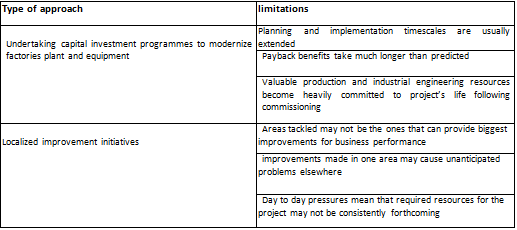Continuous Improvement: What Is It?
Introduction:
Continuous improvement can be considered as the ‘wheels’ of the organisational vehicle. It is the effort produced by the wheels which will make the vehicle move forward. The traditional approach towards improvement lacked in consistency, in will and determination and in measurement of effort made, which are all necessary if superior performance is to be achieved in a modern business environment.
Traditional approach to continuous improvement:

Various proposals have been put forward to explain what needs to be done to change the approach to continuous improvement.
1 Use of critical thinking skills for effective problem-solving4 The wealth of specialized knowledge in any business is far more important than any technological sophisticated innovation. More emphasis needs to be placed on people.
2 Continuous improvement is not a standard management practice? Continuous improvement requires critical thinking and management techniques such as SPC.
3 The customer is the next process in the chain. Customer feedback and input should not be regarded as a necessary evil but more as an opportunity for conducting improvement.
4 Create a management system which will consider continuous improvement as a never-ending activity:
Conway suggests the following:
To improve all work processes we must know about all the work at all levels. We use our knowledge and understanding of these work processes to find the problems, errors, complexities and waste, and get rid of them. The company must improve internal and external processes, seeking to measure and improve quality with a customer focus. Customers define quality, and we continuously improve our processes to give them the quality services and products they require.
5 Quality at the heart of business strategy: This point was raised by various gurus and champions of quality. Juran for instance argued that what was missing in the West is a ‘grand strategy’ which puts quality into the business plan. He suggested the following six steps for establishing a strong continuous improvement programme.
6 Total optimization: Using people’s skills and knowledge so that they are no longer confined to a localized area but geared towards a total goal oriented organization. Optimization can be achieved by providing people with the necessary tools and direction, by creating a supportive environment and by sharing results with everyone concerned.